Caution: Do not move the vehicle until a firm brake pedal is obtained. Air in the brake system can cause loss of brakes with possible personal injury.
Caution: Use only SUPREME 11 or equivalent DOT 3 brake fluid from a clean, sealed container. Do not use fluid from an open container that may be contaminated with water. Improper or contaminated fluid will result in damage to components or loss of braking, with possible personal injury.
Caution: Do not overfill the brake fluid reservoir. Overfilling the brake fluid reservoir may cause the brake fluid to overflow onto the engine exhaust components during brake system service. The brake fluid is flammable and may cause a fire and personal injury if the brake fluid contacts the engine exhaust system components.
Notice: If any brake component is repaired or replaced such that air is allowed to enter the brake system, the entire bleeding procedure must be followed.
Notice: Avoid spilling brake fluid on any of the vehicle's painted surfaces, wiring, cables, or electric connectors. Brake fluid will damage the paint and the electrical connections. If any fluid is spilled on the vehicle, flush the area to lessen the damage.
Notice: Prior to bleeding the brakes, the front and rear displacement cylinder pistons must be returned to the topmost position. The preferred method uses a Scan Tool to perform the rehoming procedure. If a Scan Tool is not available, the second procedure may be used, but it is extremely important that the procedure be followed exactly as outlined.
Important: A Pressure Bleeding operation is necessary in order to remove air properly whenever the Brake Pressure Modulator Valve has been removed or replaced.
Important: A bleeding operation is necessary in order to remove air when air is introduced into the hydraulic brake system.
Bleed the hydraulic system at all four brakes if air has been introduced through a low fluid level or by disconnecting brake pipes at the master cylinder. If a brake hose or brake pipe is disconnected at one wheel, bleed only that one wheel caliper. If brake pipes or hoses are disconnected at any fitting located between the master cylinder and the brakes, then only bleed the brake system served by the disconnected pipe or hose.With Scan Tool (Preferred Method)
Refer to Antilock Brake System Automated Bleed Procedure In Antilock brake system.
Without Scan Tool
- Remove foot from the brake pedal.
- Start the engine. Allow the engine to run for at least ten seconds while observing the amber ABS warning indicator.
- If the amber ABS warning indicator turns on and stays on after ten seconds, stop the bleeding procedure. Use a Scan Tool in order to diagnose the ABS malfunction.
- If the amber ABS warning indicator turns on for approximately three seconds, then turns off and stays off, turn the ignition off.
- Repeat the previous four steps one more time.
- Bleed the entire brake system.
Notice: This method can only be used if the amber ABS warning indicator is not illuminated and no DTCs are present.
Important: Do not place your foot on the brake pedal through this entire procedure unless specifically directed to do so.
Brake System Pressure Bleeding Procedure
Tools Required
| • | J 29532 Diaphragm Type Brake Bleeder |
| • | J 35589 Brake Bleeder Adapter |
Notice: Pressure bleeding equipment must be of the diaphragm type. It must have a rubber diaphragm between the air supply and the brake fluid to prevent air, moisture, and other contaminants from entering the hydraulic system.
Notice: Avoid spilling brake fluid on any of the vehicle's painted surfaces, wiring, cables, or electric connectors. Brake fluid will damage the paint and the electrical connections. If any fluid is spilled on the vehicle, flush the area to lessen the damage.
- Inspect and fill the master cylinder reservoir to the proper level as necessary. Refer to Master Cylinder Reservoir Filling .
- Assemble the components as shown.
- Install the J 35589 to the master cylinder reservoir.
- Connect the J 29532 to theJ 35589 .
- Adjust theJ 29532 to 35-70 kPa (5-10 psi).
- Wait approximately 30 seconds, then inspect the entire hydraulic brake system in order to ensure that there are no existing brake fluid leaks. Repair any brake fluid leaks.
- Adjust theJ 29532 to 205-240 kPa (30-35 psi).
- Slowly open the ABS modulator brake pipe fitting (1) starting from the first pipe on the left side in order to allow the brake fluid to flow.
- Close the ABS modulator brake pipe fitting when air bubbles are no longer detected in the brake fluid.
- Repeat Steps 8 and 9 for the remaining ABS modulator brake pipe fittings.
- Raise and suitably support the vehicle. Refer to Lifting and Jacking the Vehicle in General Information.
- Install the clear plastic bleeder hose to the RIGHT REAR wheel cylinder bleeder valve:
- Submerge the opposite end of the clear plastic bleeder hose in a clean container partially filled with clean brake fluid.
- Slowly open the bleeder valve in order to allow the brake fluid to flow.
- Close the bleeder valve when air bubbles are no longer detected in the brake fluid.
- Remove the clear plastic bleeder hose from the bleeder valve.
- Install the clear plastic bleeder hose to the LEFT FRONT brake caliper bleeder valve.
- Submerge the opposite end of the clear plastic bleeder hose in a clean container partially filled with clean brake fluid.
- Slowly open the bleeder valve in order to allow the brake fluid to flow.
- Close the bleeder valve when air bubbles are no longer detected in the brake fluid.
- Remove the clear plastic bleeder hose from the bleeder valve.
- Install the clear plastic bleeder hose to the LEFT REAR wheel cylinder bleeder valve.
- Submerge the opposite end of the clear plastic bleeder hose in a clean container partially filled with clean brake fluid.
- Slowly open the bleeder valve in order to allow the brake fluid to flow.
- Close the bleeder valve when air bubbles are no longer detected in the brake fluid.
- Remove the clear plastic bleeder hose from the bleeder valve.
- Install the clear plastic bleeder hose to the RIGHT FRONT brake caliper bleeder valve.
- Submerge the opposite end of the clear plastic bleeder hose in a clean container partially filled with clean brake fluid.
- Slowly open the bleeder valve in order to allow the brake fluid to flow.
- Close the bleeder valve when air bubbles are no longer detected in the brake fluid.
- Remove the clear plastic bleeder hose from the bleeder valve.
- Lower the vehicle.
- Remove the J 35589 from the master cylinder reservoir.
- Inspect and fill the master cylinder reservoir to the proper level as necessary. Refer to Master Cylinder Reservoir Filling .
- Install the master cylinder reservoir cap.
- Start the engine and allow the engine to run for at least 10 seconds.
- Turn the ignition OFF.
- Inspect the brake pedal feel and the brake pedal travel. Refer to Brake Pedal Travel .
- Start the engine and inspect the brake pedal feel.
- Use the scan tool in order to perform the automated bleed procedure. Refer to Antilock Brake System Automated Bleed Procedure in Antilock Brake Systems.
- Ensure that the unacceptable brake pedal feel/travel is not caused by misadjusted brake linings or other mechanical failures, then repeat the Brake System Pressure Bleeding procedure. Proceed to Step 1.
- Road test the vehicle. Make several normal (non-ABS) stops from a moderate speed in order to ensure proper brake system function. Allow adequate brake system cooling time between stops.
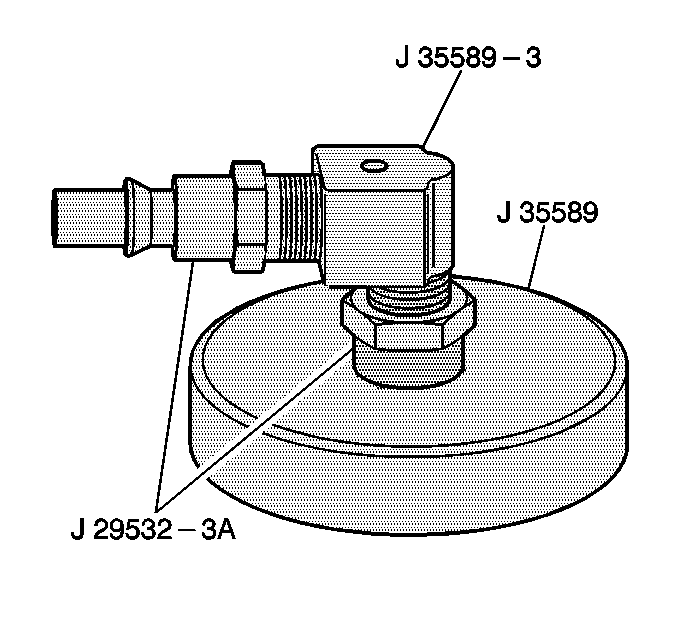
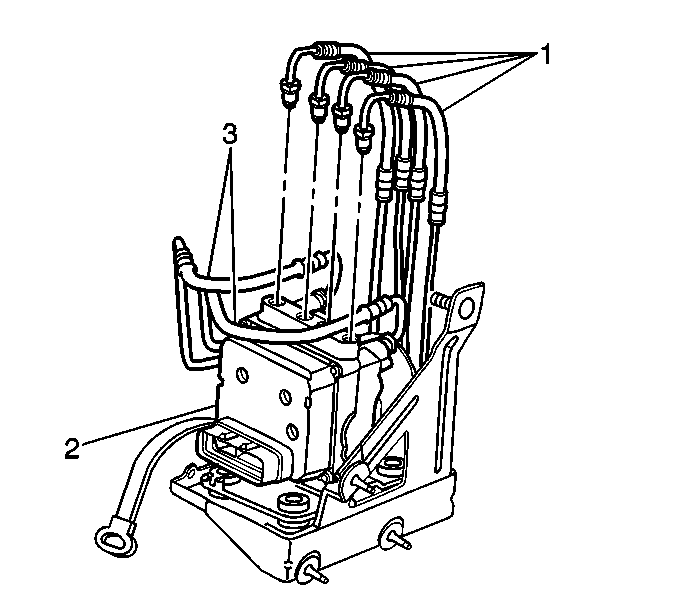
Important: Use a shop cloth in order to catch escaping brake fluid.
Notice: Use the correct fastener in the correct location. Replacement fasteners must be the correct part number for that application. Fasteners requiring replacement or fasteners requiring the use of thread locking compound or sealant are identified in the service procedure. Do not use paints, lubricants, or corrosion inhibitors on fasteners or fastener joint surfaces unless specified. These coatings affect fastener torque and joint clamping force and may damage the fastener. Use the correct tightening sequence and specifications when installing fasteners in order to avoid damage to parts and systems.
Tighten
Tighten the ABS modulator brake pipe fitting to 24 N·m
(18 lb ft).
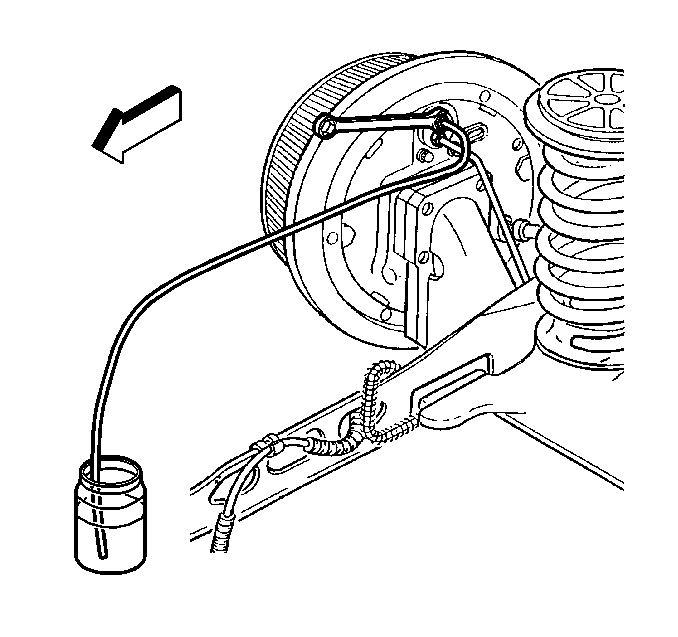
Tighten
Tighten the wheel cylinder bleeder valve to 7 N·m (62 lb in).
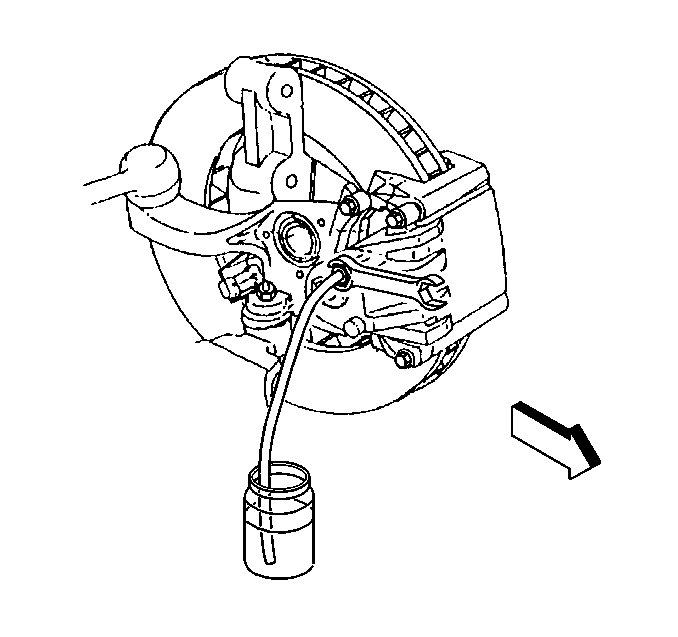
Tighten
Tighten the brake caliper bleeder valve to 13 N·m (115 lb in).

Tighten
Tighten the wheel cylinder bleeder valve to 7 N·m (62 lb in).
.
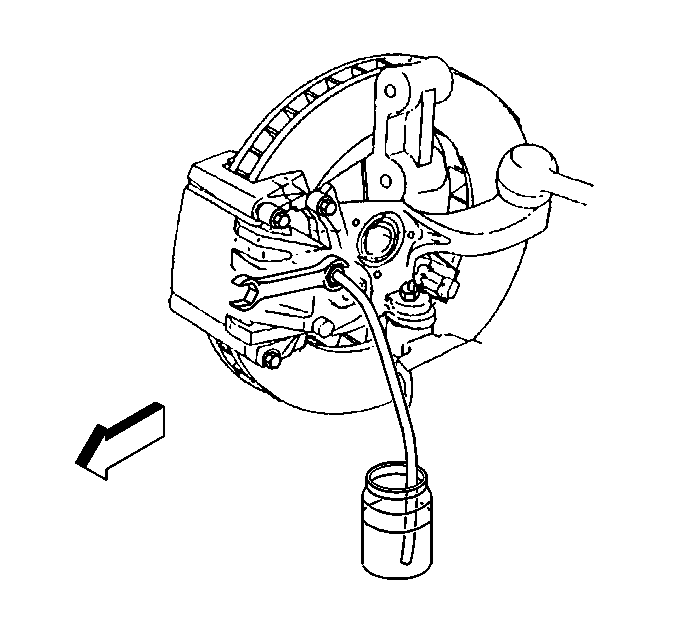
Tighten
Tighten the brake caliper bleeder valve to 13 N·m (115 lb in).
| • | If the brake pedal feels firm and constant and the brake pedal travel does not exceed specifications, proceed to Step 41. |
| • | If the pedal feels soft or the brake pedal travel exceeds specifications, DO NOT DRIVE THE VEHICLE. Go to Step 42. |
| • | If the brake pedal still feels firm, got to Step 44. |
| • | If the brake pedal feels soft, DO NOT DRIVE THE VEHICLE. proceed to Step 42. |
Caution: Do not move the vehicle until a firm brake pedal is obtained. Failure to obtain a firm pedal before moving vehicle may result in personal injury.
Brake System Manual Bleeding Procedure
Important: This procedure may require the help of an assistant to apply the brake pedal while the bleeder valves are opened and closed.
Important: Ensure that the master cylinder brake fluid level does not drop to the bottom of the master cylinder reservoir. You will be instructed to Inspect and fill the master cylinder reservoir at times during this procedure. However, the actual frequency of master cylinder reservoir filling REQUIRED will depend on the amount of fluid that is released. If the brake fluid level drops to the bottom of the master cylinder reservoir, start the bleed procedure again at Step 1.
- Inspect and fill the master cylinder reservoir to the proper level as necessary. Refer to Master Cylinder Reservoir Filling .
- Slowly open the ABS modulator brake pipe fitting (1) starting from the first pipe on the left side in order to allow the brake fluid to flow.
- Press and hold the brake pedal approximately 75 percent of a full stroke.
- Close the ABS modulator brake pipe fitting when air bubbles are no longer detected in the brake fluid.
- Repeat Steps 2 and 3 for the remaining ABS modulator brake pipe fittings.
- Inspect and fill the master cylinder reservoir to the proper level as necessary. Refer to Master Cylinder Reservoir Filling .
- Raise and suitably support the vehicle. Refer to Lifting and Jacking the Vehicle in General Information.
- Install the clear plastic bleeder hose to the RIGHT REAR wheel cylinder bleeder valve.
- Submerge the opposite end of the clear plastic bleeder hose in a clean container partially filled with clean brake fluid.
- Open the bleeder valve.
- Press and hold the brake pedal approximately 75 percent of a full stroke.
- Close the bleeder valve.
- Release the brake pedal.
- Repeat Steps 10 through 13 until air bubbles are no longer detected in the brake fluid.
- Remove the clear plastic bleeder hose from the bleeder valve.
- Install the clear plastic bleeder hose to the LEFT FRONT brake caliper bleeder valve.
- Submerge the opposite end of the clear plastic bleeder hose in a clean container partially filled with clean brake fluid.
- Open the bleeder valve.
- Press and hold the brake pedal approximately 75 percent of a full stroke.
- Close the bleeder valve.
- Release the brake pedal.
- Repeat Steps 18 through 21 until air bubbles are no longer detected in the brake fluid.
- Remove the clear plastic bleeder hose from the bleeder valve.
- Install the clear plastic bleeder hose to the LEFT REAR wheel cylinder bleeder valve.
- Submerge the opposite end of the clear plastic bleeder hose in a clean container partially filled with clean brake fluid.
- Open the bleeder valve.
- Press and hold the brake pedal approximately 75 percent of a full stroke.
- Close the bleeder valve.
- Release the brake pedal.
- Repeat Steps 26 through 29 until air bubbles are no longer detected in the brake fluid.
- Remove the clear plastic bleeder hose from the bleeder valve.
- Install the clear plastic bleeder hose to the RIGHT FRONT brake caliper bleeder valve.
- Submerge the opposite end of the clear plastic bleeder hose in a clean container partially filled with clean brake fluid.
- Open the bleeder valve.
- Press and hold the brake pedal approximately 75 percent of a full stroke.
- Close the bleeder valve.
- Release the brake pedal.
- Repeat Steps 34 through 37 until air bubbles are no longer detected in the brake fluid.
- Remove the clear plastic bleeder hose from the bleeder valve.
- Lower the vehicle.
- Remove the brake fluid reservoir cover.
- Inspect the brake fluid level in the reservoir. Refer to Master Cylinder Reservoir Filling .
- Install the brake fluid reservoir cover.
- Turn the ignition switch to the RUN position, then turn off the engine. Apply the brake pedal with moderate force and hold the pedal. Note the pedal travel and feel.
- If the pedal feels firm and constant and pedal travel is not excessive, start the engine. With the engine running, recheck the pedal travel.
- If the pedal feel is still firm and constant and pedal travel is not excessive, perform a vehicle road test. Make several normal (non-ABS) stops from a moderate speed in order to ensure proper brake system function.
- If pedal feel is soft or has excessive travel either initially or after engine start, refer to Antilock Brake System Automated Bleed Procedure in Antilock Brake Systems.
- Repeat the manual bleeding procedure, starting at Step 1.
- Perform a vehicle road test. Make several normal (non-ABS) stops from a moderate speed in order to ensure proper brake system function.

Important: Use a shop cloth in order to catch escaping brake fluid.
Notice: Use the correct fastener in the correct location. Replacement fasteners must be the correct part number for that application. Fasteners requiring replacement or fasteners requiring the use of thread locking compound or sealant are identified in the service procedure. Do not use paints, lubricants, or corrosion inhibitors on fasteners or fastener joint surfaces unless specified. These coatings affect fastener torque and joint clamping force and may damage the fastener. Use the correct tightening sequence and specifications when installing fasteners in order to avoid damage to parts and systems.
Tighten
Tighten the ABS modulator brake pipe fitting to 24 N·m
(18 lb ft).

Tighten
Tighten the wheel cylinder bleeder valve to 7 N·m (62 lb in)..

Tighten
Tighten the brake caliper bleeder valve to 13 N·m (115 lb in).

Tighten
Tighten the wheel cylinder bleeder valve to 7 N·m (62 lb in).

Tighten
Tighten the brake caliper bleeder valve to 13 N·m (115 lb in).
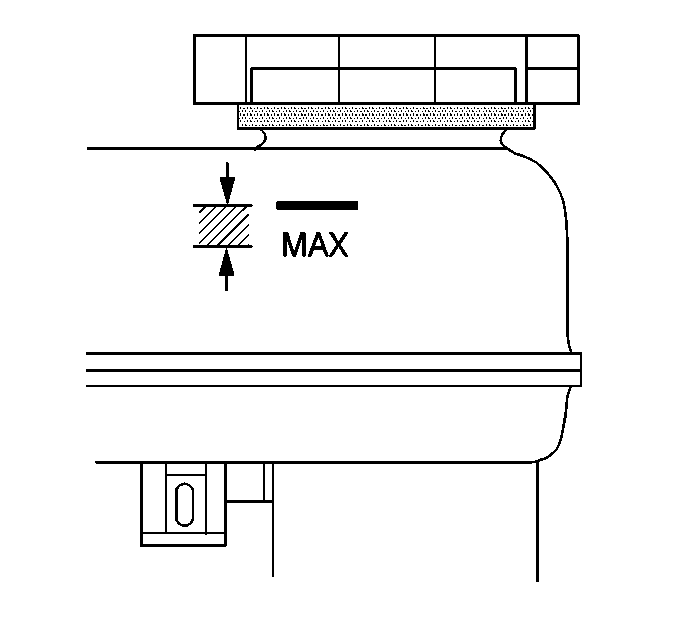
Caution: Do not move the vehicle until a firm brake pedal is obtained. Failure to obtain a firm pedal before moving vehicle may result in personal injury.
